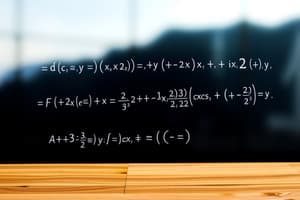Podcast
Questions and Answers
If $\lim_{(x,y) \to (x_0, y_0)} f(x,y) \neq f(x_0, y_0)$ then
If $\lim_{(x,y) \to (x_0, y_0)} f(x,y) \neq f(x_0, y_0)$ then
- function f fails to be continuous at $(x_0, y_0)$
- f is discontinuous
- f is continuous
- Both (B) and (C) (correct)
The iterated limits of function are not equal at point then
The iterated limits of function are not equal at point then
- Limit is zero
- Limit does not exist (correct)
- None
- Limit exists at point
The limit $\lim_{x \to x_0} [\lim_{y \to y_0} f(x,y)]$ and $\lim_{y \to y_0} [\lim_{x \to x_0} f(x,y)]$ are called as
The limit $\lim_{x \to x_0} [\lim_{y \to y_0} f(x,y)]$ and $\lim_{y \to y_0} [\lim_{x \to x_0} f(x,y)]$ are called as
- Repeated or iterated limit (correct)
- Left hand and right hand limit
- Double limit
- Unique limit
The necessary condition for the extremum of $f(x, y)$ is:
The necessary condition for the extremum of $f(x, y)$ is:
If $u = 2x-y; v = x+4y$ then $\frac{\partial (u,v)}{\partial (x,y)} = $
If $u = 2x-y; v = x+4y$ then $\frac{\partial (u,v)}{\partial (x,y)} = $
Study Notes
Function Continuity
-
A function f(x, y) is continuous at a point (x0, y0) if the limit of f(x, y) as (x, y) approaches (x0, y0) is equal to the value of f(x0, y0).
-
If lim(x,y)→(x0,y0) f(x,y) ≠ f(x0, y0), then the function is discontinuous at the point (x0, y0).
Limits of Functions of Two Variables
-
The limits of a function f(x, y) as x and y approach x0 and y0, respectively, can be calculated using iterated limits.
-
Iterated limits are the limits taken in one variable at a time, holding the other variable fixed.
-
If the iterated limits of a function are not equal at a point, then the limit does not exist at that point.
-
Limits of the form lim(x→x0) [lim(y→y0) f(x,y)] and lim(y→y0) [lim(x→x0) f(x,y)] are called repeated or iterated limits.
Extremum of Functions
- The necessary condition for a function f(x, y) to have an extremum at a point (x0, y0) is that both partial derivatives of f(x, y) with respect to x and y must be equal to zero at that point.
- This means that ∂f/∂x = 0 and ∂f/∂y = 0 at the point (x0, y0).
Jacobian
- The Jacobian of two functions u and v with respect to variables x and y is given by the determinant: ∂(u,v)/∂(x,y) = | ∂u/∂x ∂u/∂y | | ∂v/∂x ∂v/∂y |
Studying That Suits You
Use AI to generate personalized quizzes and flashcards to suit your learning preferences.
Description
Explore the concepts of continuity, limits, and extrema in functions of two variables. This quiz covers the conditions for continuity, iterated limits, and necessary conditions for finding extrema. Test your understanding of these fundamental calculus principles.




